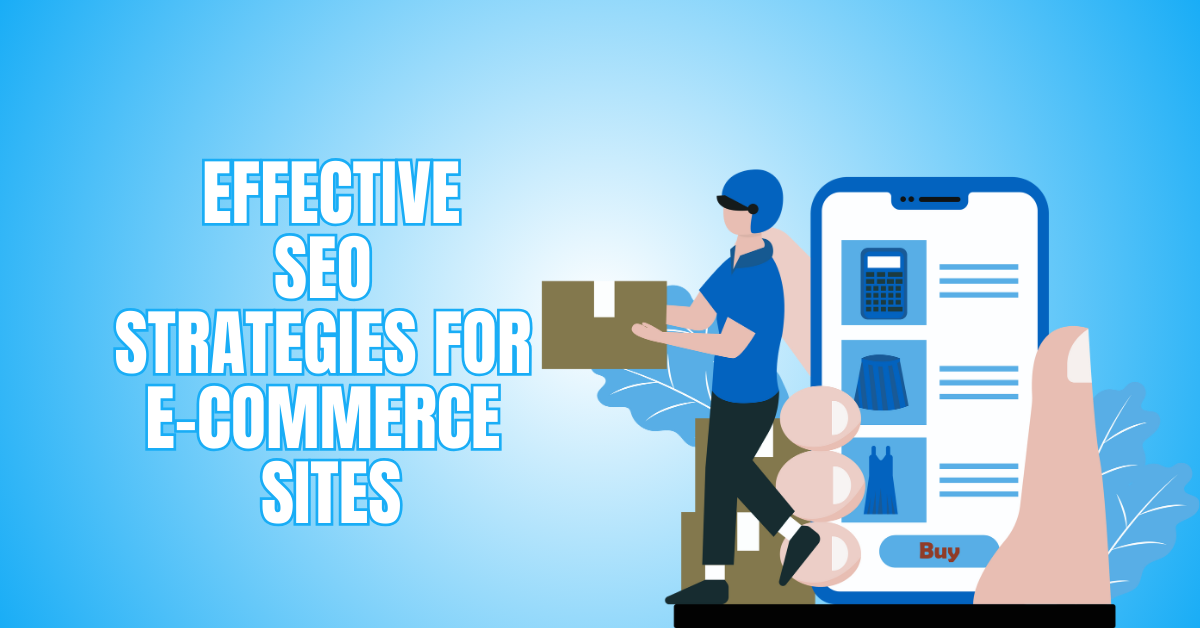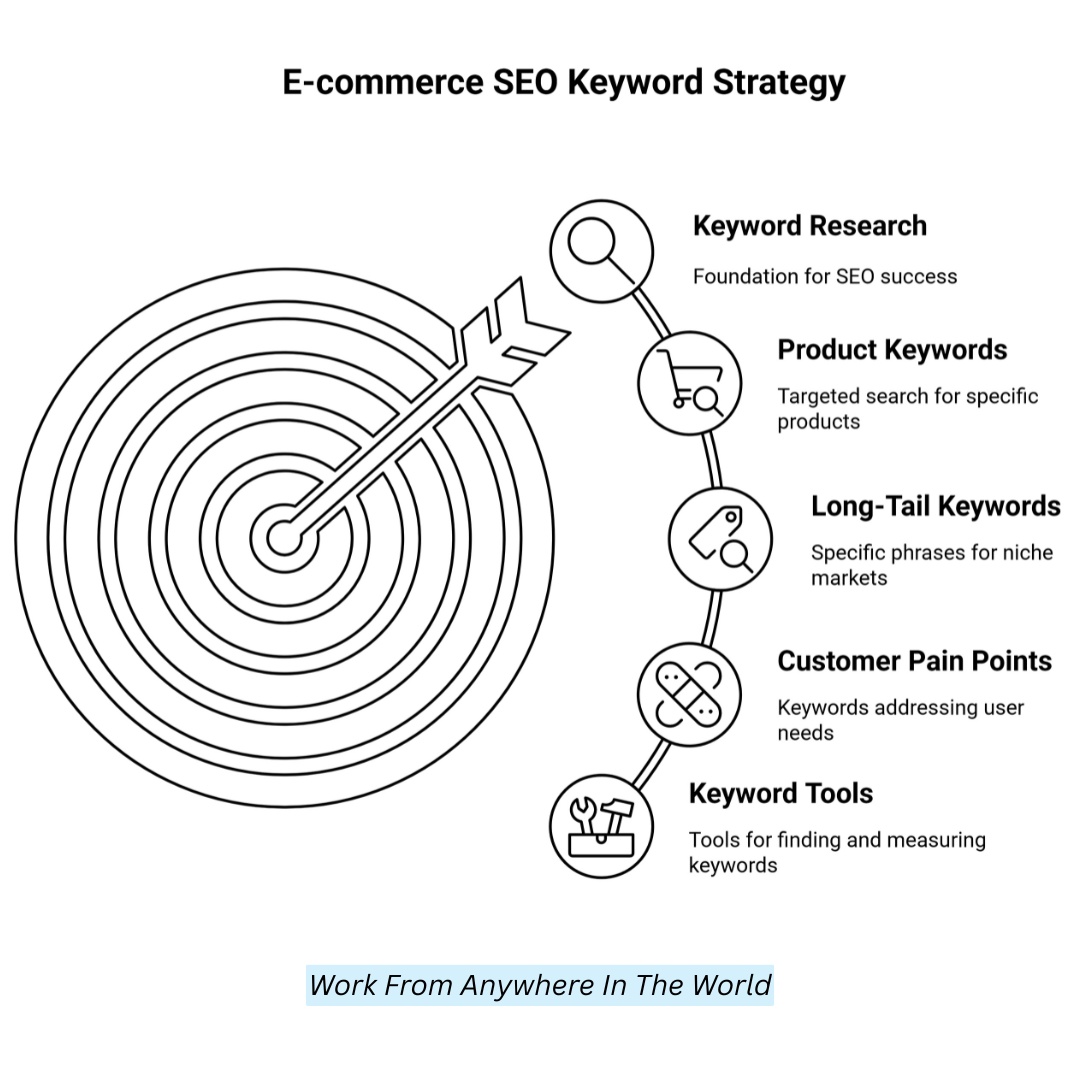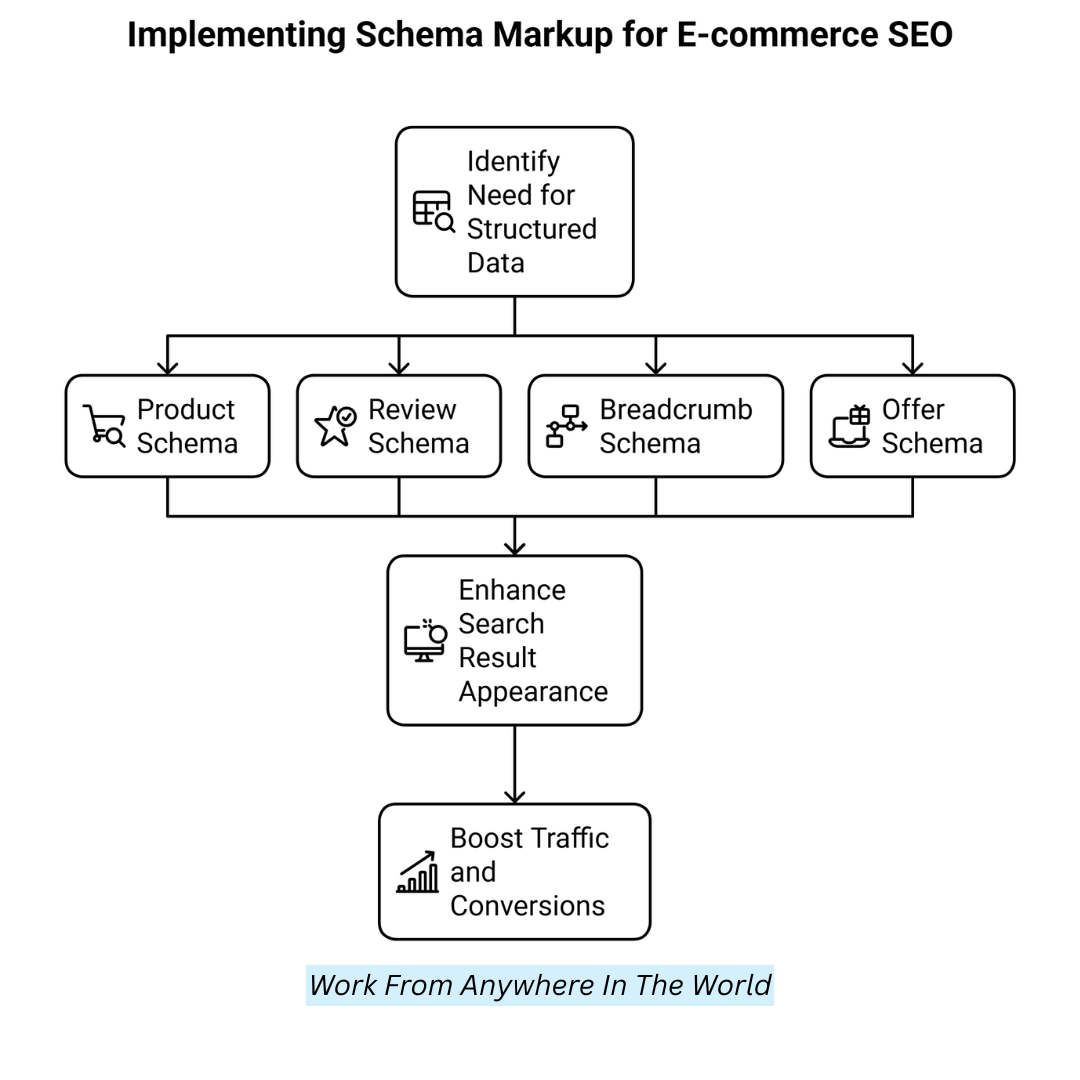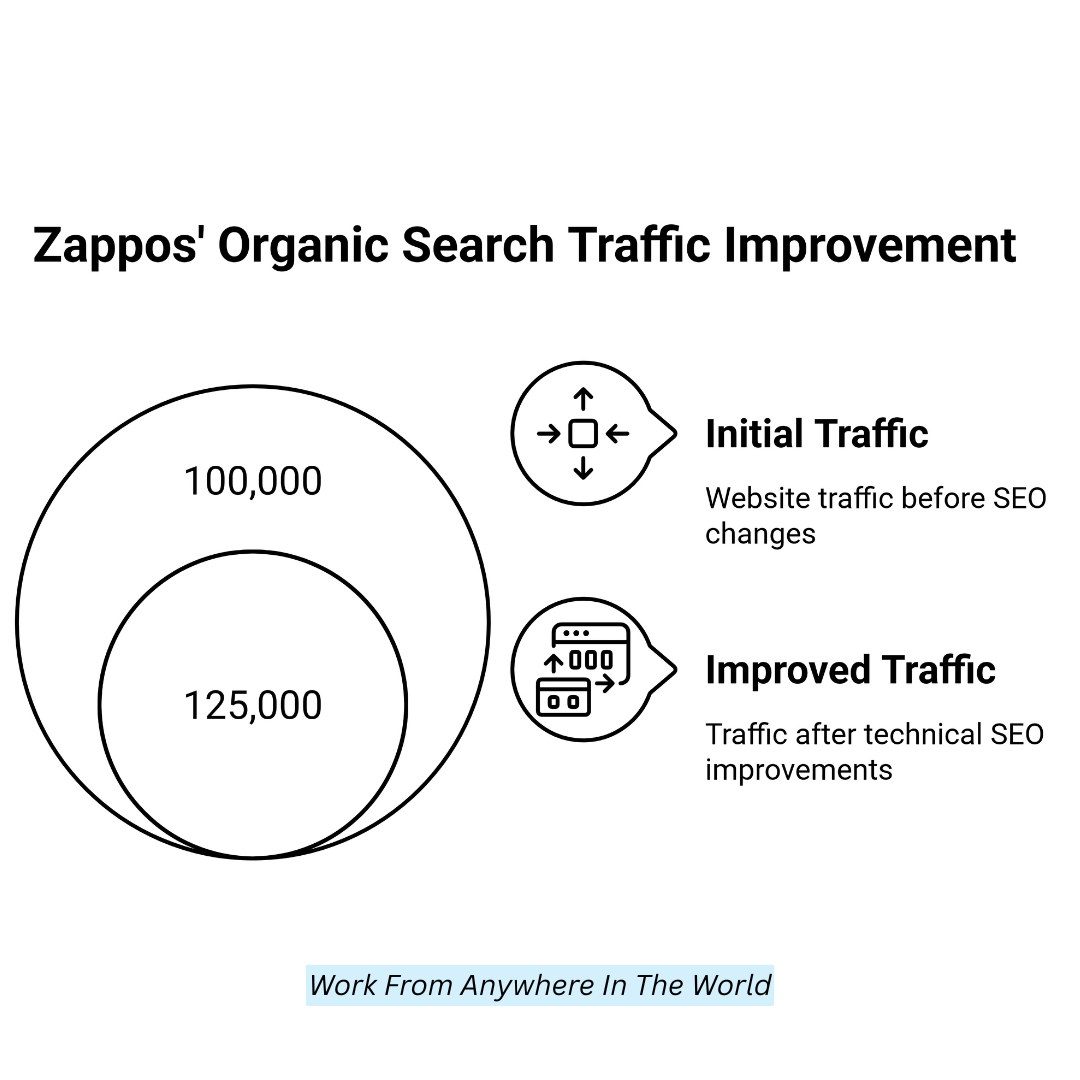Effective SEO Strategies For E-Commerce Sites
Effective SEO Strategies For E-Commerce Sites To Boost Conversions
Driving traffic and boosting sales are vital to success in today's competitive digital landscape. You can achieve this by employing one of the most valuable strategies: SEO.
Implementing SEO strategies for e-commerce sites can significantly enhance your visibility and help you capture the attention of many customers.
This blog will outline the most effective techniques for optimizing your rankings and e-commerce website. Let's now explore the growth and development strategies.

Effective SEO Strategies For E-Commerce Sites
1. Conduct Thorough Keyword Research
Thorough keyword research is the first and most crucial step in e-commerce SEO. It helps you discover precisely what your potential customers are searching for online. Using the right keywords can attract highly targeted visitors to your site.
These are people who are already interested in what you offer. Instead of relying on guesswork, keyword data gives you direction.
Among all SEO strategies for e-commerce sites, this one lays the foundation for better rankings, traffic, and conversions.
Tips For This Strategy
Product Keywords
You should focus strategically on high-intent keywords by product. For example, you could use phrases like “buy leather wallet” or “organic baby shampoo online” to reach buyers.
Long-Tail Keywords
Use long-tail keywords with low competition. Phrases like “best wireless headphones under $50” bring more qualified and specific search traffic.
Customer Pain Points
Target keywords that reflect real problems. Phrases like “how to fix dry skin” or “shoes for heel pain” match user needs.
Keyword Tools
Use resources like Ahrefs, SEMrush, and Google Keyword Planner. These help you find keyword ideas and measure search volume.
Case Study
The Zappos case study shows how keyword research helped target long-tail phrases to address customer pain points. This alone resulted in a 30% increase in organic traffic.
They increased conversions through their professional experience, as more searchers found precisely what they were looking for.

2. Optimize Product Pages
Optimizing product pages is crucial for converting casual visitors into loyal customers. A well-optimized page helps search engines discover your Content while allowing users to find what they are searching for quickly.
Pay special attention to clear titles, detailed descriptions, and high-quality visuals. Fill the page with relevant keywords, and ensure the design is user-friendly.
In addition to being where tracking excels, these pages are meant to inform and convince customers. This is one of the top SEO strategies for e-commerce sites, as it directly translates to visibility and conversions.
Tips For This Strategy
Title Tags
Include the main product keyword in the title. Keep it short, clear, and specific to match what people are searching for online.
Meta Descriptions
Write meta descriptions that capture the interest of your audience and incorporate relevant keywords. Mentioning benefits or features helps, too, so write to improve click-through rates from search results.
Want to Start Making Money Online?
Try My #1 Recommendation Program!
Product Descriptions
Avoid using manufacturer descriptions. Write unique Content that highlights features and benefits and solves customer problems in a friendly, natural tone.
Image Optimization
Use high-quality images with descriptive alt text. Include keywords in file names to improve image SEO and visibility in image searches.
Case Study
Best Buy overhauled its product pages by writing unique, customer-centric descriptions and updating the metadata. As a result, it saw a 20% increase in organic traffic, significantly increased user engagement, and generated higher sales.
3. Optimize Category Pages
Optimizing category pages is a crucial part of SEO strategies for enhancing site performance. These pages must be well-organized and keyword-optimized when you are one of many products. Well-structured category pages improve both search engine rankings and user experience.
Providing Content rich in keywords helps search engines determine which categories your input is relevant to. Proper optimization can optimize a higher number of organic traffic and, hence, more sales.
Tips For This Strategy
Category Titles
Use keyword-rich category titles that accurately describe the products. The right audience is drawn in, and visibility in search results is enhanced.
Content-Rich Descriptions
Write a unique, keyword-rich description for each category. Rewrite the benefits, features, and types of products in a way that helps users understand what X will offer, etc.
URL Structure
Use a simple, clear URL containing the most relevant keywords. For example, use yoursite.com/sneakers instead of yoursite.com/category1234.
Internal Linking
Strengthen category page authority by linking to relevant product pages. This improves crawlability, distributes link equity, and helps users find related products.
Case Study
Nordstrom optimized its capabilities by adding keyword-rich descriptions and improving URL structure. This resulted in a 15% increase in organic traffic and higher engagement, helping boost sales in key categories.

4. Enhance Site Structure And Navigation
Your SEO needs improvement in the structure and navigation of your site. A well-structured site helps users find products quickly, improving engagement and conversion.
Rankings get an enormous boost from logical navigation, mobile optimization and fast load times. These components are essential to SEO strategies for e-commerce sites since they enhance user experience and facilitate search engines' ability to scan and index your content.
Tips For This Strategy
Logical Navigation
Arrange navigation logically so that products are easier to find. No one will ever buy something from confusing categories, so create clear categories or search options to help your customers.
Mobile-Friendly Design
Adapt your website to mobile devices. A mobile-friendly design is essential for SEO, as Google prioritizes mobile-optimized sites in its rankings.
Want to Find Out How To Start Your Home-Based Business?
Try My #1 Recommendation Platform!
Fast Page Load Times
Optimize images to improve page speed. For e-commerce websites, faster load speeds are a crucial component of SEO, as they lower bounce rates and improve rankings.
Breadcrumbs
Use breadcrumb navigation to improve site structure. Breadcrumbs enhance internal linking and help search engines understand your site's hierarchy, supporting SEO efforts.
Case Study
ASOS's mobile-friendly site redesign improved load time and added breadcrumb navigation. We experienced a 25% year-over-year increase in mobile traffic, and these ranking improvements indicate the effectiveness of the SEO tactics we've implemented.
5. Use Structured Data (Schema Markup)
For e-commerce SEO, structured data, also known as schema markup, is crucial. It increases visibility, user engagement, and click-through rates by helping search engines better understand your content.
Implementing schema markup, such as product and review schemas, makes your site stand out with rich snippets in search results.
These enhancements improve SEO performance and give your site an edge in SEO strategies for e-commerce sites, boosting traffic and conversions by making your products more visible.
Tips For This Strategy
Product Schema
Use a product schema to see rich snippets like price, availability, reviews, etc. This helps your product to stand out and increases click-through rates in search.
Review Schema
Add review schema to display ratings in search results. Ratings can increase trust and entice users to click, boosting traffic and conversions for e-commerce sites.
Breadcrumb Schema
Implement a breadcrumb schema to enhance navigation and improve user experience. Breadcrumbs enable users to see their current location on your site, while also improving its organization, which is beneficial for SEO.
Offer Schema
Include offer schema to display discounts or promotions directly in search results. This can attract more clicks, increase conversions, and improve your e-commerce site's visibility.
Case Study
This case study demonstrates how Macy's implemented product, review, and offer schemas across its site to achieve rich snippets, resulting in improved click-through rates (CTR).
As a result, organic traffic increased by 20%, and click ratios improved, illustrating the effectiveness of structured data in an SEO strategy for e-commerce sites.

6. Build High-Quality Backlinks
For e-commerce websites, high-quality backlinks are a crucial component of SEO tactics. When reputable sources link back to a site, they help tell search engines that the site is a reliable source, which is reflected in the site's domain authority, rankings, and visibility.
Getting links from related websites in your niche helps you get more visitors, perform better in search results, and build credibility. Good backlinking adds credibility to your site and widens your reach, helping you attract more customers.
Tips For This Strategy
Guest Posting
Write articles for blogs or websites in your industry to get backlinks. By guest posting on such sites, you build credibility for yourself and increase organic traffic to your e-commerce site.
Influencer Marketing
Work with influencers to create backlinks. Influencers usually have high domain authority, which can boost your site's SEO and funnel qualified traffic.
Product Roundups
Pitch your products in product roundups and lists. Being featured on their list can provide quality backlinks and referral traffic, which might also help SEO.
Are You Tired Of Scams?
Want to Start Making Money Online?
Content Marketing
Develop Content that people want to share with others. Others can share quality blog posts, guides, or infographics, helping generate organic backlinks and extend reach.
Case Study
Amazon successfully used guest posting and influencer marketing to build high-quality backlinks. This strategy resulted in a 30% increase in organic traffic, improved SEO rankings, and higher product visibility across multiple channels.
7. Create Valuable And SEO-Friendly Content
Content written around your customers' needs is one of the best SEO strategies for e-commerce sites. Valuable Content drives organic traffic, builds authority, encourages time on site, and allows for internal linking.
Its informative blog posts, buying guides, FAQS, and how-to articles answer customer questions while improving engagement and SEO performance.
This strategy also helps e-commerce businesses stand out in competitive markets and establish long-term relationships with potential buyers.
Tips For This Strategy
Publish Informative Blog Posts
Informative blog posts—on trends, buying guides, or tips for using products—can help fuel that process.
Use Long-Tail Keywords
Incorporate long-tail keywords naturally in your Content to target specific search intents and increase qualified traffic.
Optimize On-Page SEO
To support SEO efforts, each post or guide should have relevant headings, internal links, image alt texts, and proper meta descriptions.
Incorporate Product Mentions
Strategically link to your product pages within blog content to boost internal linking and improve page authority.
Update Content Regularly
Refresh older posts with updated information and keywords to maintain rankings and relevance.
Case Study
Zappos introduced a “Shoe Buying Guide” and updated its blog content to reflect seasonal trends and customer queries.
Consequently, they improved their organic search traffic by 32.6% and their positioning for highly competitive product-specific keywords. Their success demonstrates the importance of content creation in an SEO strategy for e-commerce sites.

8. Optimize For Local SEO
Local businesses must invest in Local SEO to drive customers to their area. By optimizing for local search, you can improve visibility in location-based searches and attract more relevant traffic.
Great local SEO strategies for e-commerce sites will improve foot traffic to physical stores and online orders for customers nearby.
Optimizing your business profile, collecting local business reviews, and adding location-based keywords can help give your site a leg up in search results in your local area.
Tips For This Strategy
Google My Business
Create and optimize your Google Business profile. Make sure your business information is correct, which can boost your visibility in e-commerce sites, local searches and maps.
Local Keywords
Use location-based keywords in product titles and descriptions. For e-commerce sites, adding the city or region to your keywords might increase their exposure in local search results.
Want To Learn How To Create Your Own Website And Online Business?
Try My #1 Recommendation Training And Hosting Platform!
Local Reviews
Encourage reviews from local customers, which can help boost local SEO. Good reviews help you rank higher in local search results and gain the trust of search engines.
Local Citations
Ensure your company is listed on local maps and directories. Accurate citations from trusted sources enhance local rankings and facilitate easier customer discovery of your site.
Case Study
A local clothing store optimized its Google Business profile, added location-based keywords, and encouraged local reviews. This resulted in a 40% increase in local traffic, a 30% rise in sales, and enhanced local visibility.
9. Focus On Technical SEO
It's essential to utilize technical SEO to optimize your website's speed and ensure that search engines can effectively crawl and index it.
Technical SEO strategies for e-commerce sites help ensure better rankings, quicker load times, and a more seamless user experience overall.
Optimizing XML sitemaps and robots.txt files, as well as fixing broken links, can drastically improve site performance. This makes it easier for search engines to find, crawl, and rank your pages, ultimately boosting your site's visibility and traffic.
Tips For This Strategy
XML Sitemap
To get your site indexed, create and submit an XML sitemap. This helps search engines locate and index your product pages, improving visibility and promoting higher rankings.
Robots.txt File
Ensure your robots. The transfer method and options are in ASCII format. By filtering out irrelevant sites, this file is an excellent approach to notify search engines to efficiently crawl your site, which will aid in indexing and SEO.
Fix Broken Links
Regularly check and fix broken links on your site. Fixing broken links promptly is crucial for maintaining a website's health, as they can negatively impact both user experience and search engine rankings.
Canonical Tags
Canonical tags can help you solve duplicate content issues. This is where canonical tags come into play, alerting search engines to the preferred version of a page and avoiding penalties for duplicate Content while boosting SEO.
Case Study
Zappos enhanced its technical SEO by submitting an XML sitemap, resolving broken links, and utilizing canonical tags. Consequently, rankings improved, and organic search traffic rose by 25%.

Common E-Commerce SEO Challenges
1. Duplicate Content
E-commerce sites often encounter duplicate content issues due to the use of identical product descriptions across multiple platforms or pages. This redundancy can confuse search engines, resulting in lower rankings for pages. Without unique content, rankings suffer, and visibility decreases.
2. Thin Content
Many product pages feature brief descriptions or auto-generated text, offering minimal value to both users and search engines.
Thin content lacks the necessary keywords, depth, and relevance, making it harder for these pages to rank for competitive search terms.
3. Site Architecture Issues
A poorly structured site, with deep nesting or disorganized categories, can make it difficult for search engines to crawl and index product pages.
This results in essential pages being overlooked or ignored, which affects their chances of ranking well in search engine results.
4. Slow Page Speed
Large image files, unoptimized code, and unnecessary scripts can slow down an ecommerce site. A website that loads slowly has a detrimental impact on user experience, leading to increased bounce rates and decreased conversion rates. Page speed is also taken into account by search engines like Google when determining rankings.
5. Poor Mobile Experience
With a majority of ecommerce traffic coming from mobile devices, having a non-responsive or poorly designed mobile site is a significant issue.
Users may find it challenging to explore, check out, and navigate on mobile devices, which could result in higher bounce rates and lower engagement.
6. Lack Of Structured Data
Structured data, such as product prices, reviews, or availability, helps search engines understand the context of your content more effectively.
Rich snippets or essential product information could be difficult for search engines to display without schema markup. This can reduce your site's visibility in search results.
7. Out-of-Stock Or Discontinued Products
Pages with out-of-stock or discontinued products create dead ends for both users and search engines. These pages still exist on the site, but they no longer serve a purpose. Proper handling, such as redirects or status updates, is necessary to avoid SEO issues.
Conclusion
Finally, a proper SEO strategy for e-commerce sites will ensure sustainable success. These strategies will help you increase your site's visibility, traffic, and sales by optimizing keyword research, product and category pages, technical SEO, and high-quality backlinks.
Suppose you're consistently tracking that performance and using data-driven decisions. In that case, your e-commerce site will not only be competitive, but it will also be able to challenge itself in the search rankings. You're well on your way to successful e-commerce in the digital age!
I trust you enjoyed this article about the Effective SEO Strategies For E-Commerce Sites To Boost Conversions. Please stay tuned for more articles. Take care!
JeannetteZ
Want to Learn How to Build Your Own Home-Based Online Business And Start Making Money Online From Your Comfortable Couch?
Try Wealthy Affiliate!
Your Opinion Is Important To Me
Do you have thoughts, ideas, or questions? I would love to hear from you. Please share your questions, experiences, remarks, and suggestions about the Effective SEO Strategies For E-Commerce Sites To Boost Conversions in the comments below. You can also email me at Jeannette@WorkFromAnywhereInTheWorld.com.
Disclosure
This post may contain affiliate links. I earn from qualifying purchases as an Amazon Associate and through other affiliate programs. Please read my full affiliate disclosure.
You may also enjoy the following articles:
Wealthy Affiliate Coupons For Premium Memberships
Wealthy Affiliate Review – Scam or Legit? The Truth Exposed
An Insider Wealthy Affiliate Review
Best TikTok Ad Examples To Skyrocket Your Sales
Best TikTok Ad Examples To Skyrocket Your Sales
Social Media Advertising Costs That Boost Your Brand
Ultimate Guide To TikTok Advertising Formats That Skyrocket Your Brand's Success







